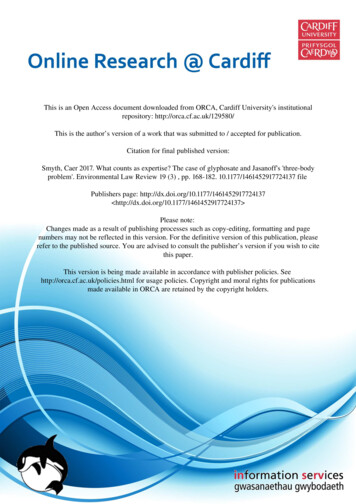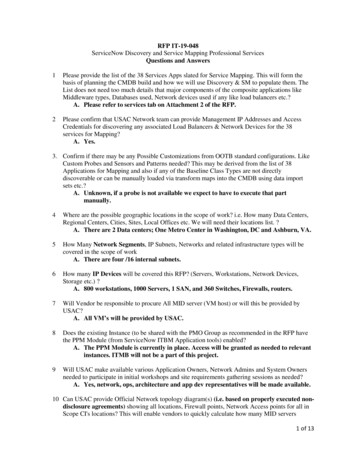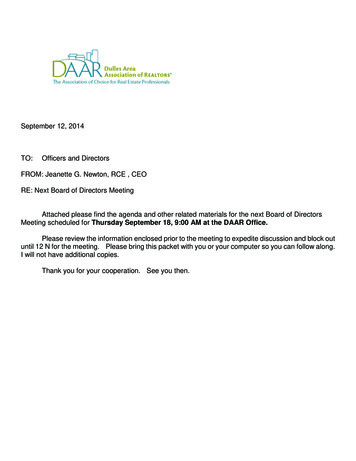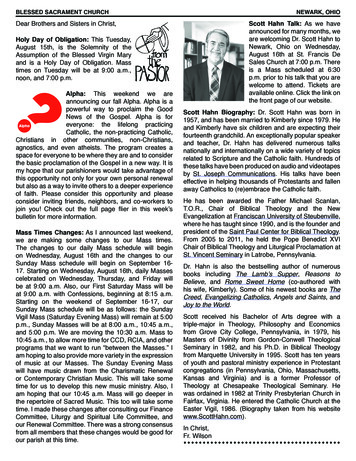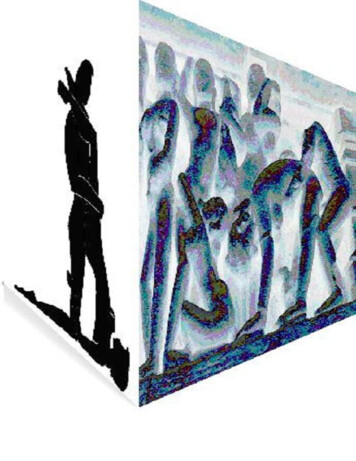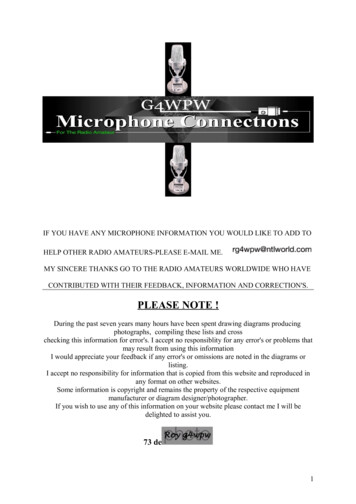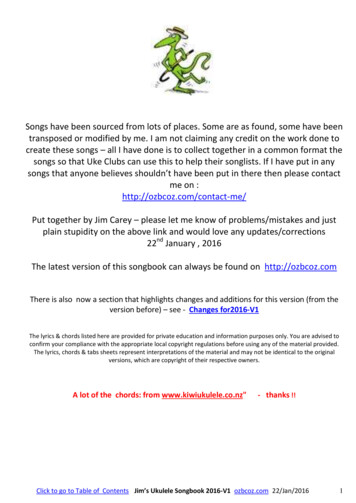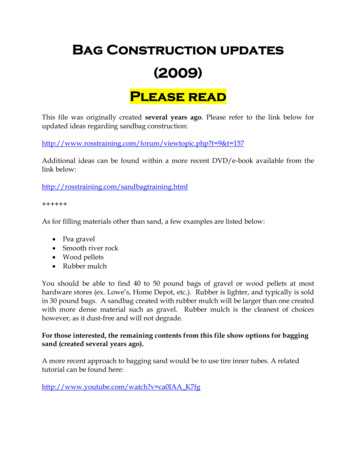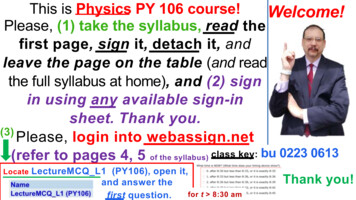
Transcription
This is Physics PY 106 course!Welcome!Please, (1) take the syllabus, read thefirst page, sign it, detach it, andleave the page on the table (and readthe full syllabus at home), and (2) signin using any available sign-insheet. Thank you.(3)Please, login into webassign.net(refer to pages 4, 5 of the syllabus) class key: bu 0223 0613LocateLectureMCQ L1 (PY106), open it,and answer thefor t 8:30 amfirst question.Thank you!
Mr. VFor the full description,Please e/0QzZ3nnmguE
Please, logininto your webassign.net/webassignaccount(pages 4, 5)(class key:bu 0223 0613)02230613
Important things to remember1. This coming Friday is on Wednesday's schedule;2. Last day to drop the course: July 9;3. Last day to withdraw: July 25;4. The final grade will be calculated on 08/10 andfinalized on 08/11, there will be NO communicationafter 08/11, hence it is very important to make surethat on 08/10 there are no missing grades for labs,HW, or participation.
Important things to remember (cont.)Hi Mr V, I just noticed my grade for Lab 4 hasnot been entered into Blackboard, although I attended and completed the lab.I can send you pictures of the completedpacket if need be. Please let me know if youneed anything else from me.Thank you so much!07/01 10:21 amiPhone and iPad users Try different browsers!Will be lostin PY106You’ve beenWarned!
In 2014 Boston 0-global-universities/University wasbeen named 37thof 500 “BestGlobalUniversities”.Everyone can get an A !(in principle)Success effort background( expectations)The tale of two frogshttps://www.youtube.com/watch?v fJA8IGP6q4Yactual plannigactualamount of work goodgrade 100 luck(5%)required planning required amount of work bad
Lectures: up to 5 lectures are allowed to bemissed due to unforeseen circumstances.Labs IL L D: 8 best grades will be used.Homework: To pass the course a studentmust have at least 50% of the maximumhomework grade.All homework assignments will be accountedfor the final grade.
The components of the grade:lectures – 7 % (webassign/signing in);IL/units – 16 %; Usually 7/8 problemsNO MAKEUPS!HW – 14 %BU policyhttp://www.bu.edu/academics/cas/exams – 20 %policies/21 %22 %TG 7 *LactILactHWactE1actE2actE3act 16 * 14 * 20 * 21* 22 *L maxIL maxHW maxE1maxE2 maxE3max
Recommended timeline Solving on average 3 or4 problems EVERY day.In addition to Lectures, labs, notes HW, notes 2-3 hours a day (on average)https://www.umflint.edu/advising/surviving college.htmfor more -norm/In special cases HWdeadline can be movedby about a day.
8 best gradeswill beaccountedtoward thefinal grade.Unit sections (IL, or labs):begin 08/05 (no labs today). A usuallab room is SCI 128, but sometimes alab may be held in different room.
Room location
Investigative laboratoriesPlease, do not usecomputers for anythingnot related to your study,Thank you.
The components of the grade:lectures – 7 %;IL/units – 16 %;HW – 14 %exams – 20 %21 %22 %TG 7 *7 16 14 37 %of “easy money”The best strategy isNOT losing anypoints!LactILactHWactE1actE2actE3act 16 * 14 * 20 * 21* 22 *L maxIL maxHW maxE1maxE2 maxE3max
The components of the course:LecturesInvestigative LaboratoriesHWExamsExam 1:Exam 2:Exam 3:COM 101COM 101COM 101Intensecourse!Don’t mixwith otherintensecourses9:00 – 11:00 July 169:00 – 11:00 July 309:00 – 11:00 Aug 10
Exam problemsTrain yourselfin recognition!similarProblems:1.HW2.Lectures3.Units (IL)Practice HWPractice examsAfter a lecture: (videos, notes)Clarification HW (solving reflecting) IL (doing reflecting) office hours, piazza (collaborating)
The actual OHschedule isposted on BB
Need to review
week 1: (do not read this slide)electric charge; neutral; charging and discharging; charging by acontact; charging by induction; grounding; conductors and insulators;elementary charge; triboelectric series; 1 C; isolated system;conservation of charge; electrostatic force; coulomb’s law; the principleof superposition; calculating the net electrostatic force; electric field;electric field of a single charge; electric field vectors; electric field lines;calculating the net electric field; electric field near and insideconductors; kinetic and potential energy; work–kinetic energy theoremand law of conservation of energy; electric potential energy for twocharges; electric potential energy for the system of charges; electricpotential; electric potential energy of a charge in a field; 1 V; electricpotential of a single charge; electric potential of a system of charges;equipotential; uniform electric field; potential in a uniform electric fieldand relation with electric filed.
Webassign: L1 Q2Page 6(the syllabus)webassign.net/
Webassign: L1 Q2Page 6(the syllabus)webassign.net/
The observed force is Webassign: L1 Q31. GravitationalPage 6 (the syllabus)2. Elastic3. Frictional4. Buoyant5. None of theabove6. All of theabove
The observed force is Webassign: L1 Q31. GravitationalPage 6 (the syllabus)2. Elastic3. Frictional4. Buoyant5. None of theabove6. All of theabove
The observed force is 1. Gravitational2. Elastic3. Frictional4. Buoyant5. None of the above6. All of the aboveWebassign: L1 Q3
https://en.wikipedia.org/wiki/Etymology of electricityThe observed force is 1. Gravitational2. Elastic3. Frictional4. Buoyant5. None of the aboveElectric Force
Coulomb's law qQ F k 2rCoulomb'sconstant 2Nmk 9 *102C9(or opposite)
Webassign: L1 Q4
Webassign: L1 Q4
m p 2000meIn solids
A neutral atom has exactly the same numberof electrons and protons.N e N PA neutral object has exactly the same numberof electrons and protons.N e N PWebassign: L1 Q5An object which has a deficiency of electrons(Ne Np) .1. is positively charged2. is negatively charged3. could be both, either positive or negative
A neutral atom has exactly the same numberof electrons and protons.N e N PA neutral object has exactly the same numberof electrons and protons.N e N PWebassign: L1 Q5An object which has a deficiency of electrons(Ne Np) .1. is positively charged2. is negatively charged3. could be both, either positive or negative
If you have a charged plastic rod, what can you doto discharge it (i.e. to make it neutral)?
If you have a charged plastic rod, what can you doto discharge it (i.e. to make it neutral)? Aluminum foil
(or a soda can)
(or a soda can)
Charging an electroscope
Charging an electroscope
The summaryAlways aska question“Whatwouldelectronsdo?”
Playing withelectroscope!On an insulator(i.e. plastic rod)electrons are“sticking” to theplaces and needto be “scratchedoff”
In conductors, electronsare moving from astronger negativelycharged object onto lessnegatively chargedobject (from a place withmore electrons to aplace with lesselectrons).
In conductors,electrons aremoving froma stronger negativelycharged object onto less negativelycharged object (from a place withmore electrons to a place with lesselectrons).
e 1.6*10-19 C1.2. Electrons“hate”, i.e.repel eachother.3. Protons are “lazy”, i.e. don’t move.4. Qof object Np – Ne * e Nextra or missing electrons * e
No need to readN- Np - NeN- Ne - Np
Set:e 1.6*10-19 CWe charge two plastic spheres, bring themto touch each other, and then move apart.Webassign: L1 Q61. Each sphere just keep its own originalcharge.2. Each sphere changes its charge.
e 1.6*10-19 CAn insulator! Not a conductor!We charge two plastic spheres bring them totouch each other and move apart.Webassign: L1 Q61. Each sphere just keep its own charge.2. Each sphere changes its charge.
e 1.6*10-19 CTwo identical chargedmetallic spheres.Two spheres are brought into acontact and then separatedagain. How many electrons andin which direction have beentransferred during the contact?
e 1.6*10-19 CTwo identical chargedmetallic spheres.Two spheres are brought into acontact and then separatedagain. How many electrons andin which direction have beentransferred during the contact?
Webassign: L1 Q7During the contact electronswill be moving .1. A to B2. B to A3. In circles4. In squares5. Electrons never move6. Electrons are sad
Webassign: L1 Q7During the contact electronswill be moving .1. A to B2. B to A3. In circles4. In squares5. Electrons never move6. Electrons are sad
Two identical charged metallic spheres.Spheres are brought into acontact and then separatedagain. How many electronsand in which direction have been transferredduring the contact?
Webassign: L1 Q7During the contact electronswill be moving .1. A to B2. B to A
For the answers, follow to the next slide.
This is Physics PY 106 course! Please, (1) take the syllabus, read the first page, signit, detachit, and leave the page on the table (and read the full syllabus at home), and (2) sign in using any available sign-in sheet. Thank you. Please, login into webassign.net (refer to pages 4, 5

